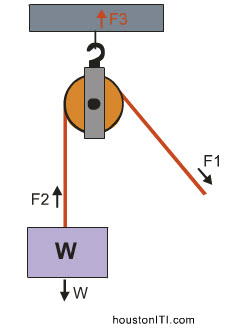 |
Pulley Force Diagram
In this section we will examine the nature of forces which are created when a pulley is used.
The figure shows a simple pulley. Recall from the previous page that at the beginning, the weight is supported at the bottom on the left hand side, no force (to lift it) is applied on the other end. Therefore in the initial stage, the rope has no tension in it. In fact there is no force acting anywhere - since we assume the pulley and the rope to be weightless - also since the weight is resting on ground, thus having no impact on the rope that is attached at its top.
The illustration provided here shows the system after we start to apply the pulling force to the rope on the right hand side. This is what happens:
a. On the left hand side, the rope experiences two forces. First, the weight W acts downward. Second, due to our pulling action the rope experiences an upward force. If the upward force is slightly greater than W, the weight is lifted.
b. Our pulling force F1, creates tension in the rope. This tension is transmitted to the left hand side as F2 - acting upward. When F2 is equal to W (or slightly greater), W is lifted. Therefore for our practical purposes: F2 = W.